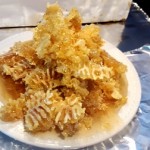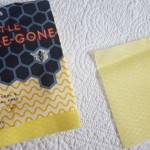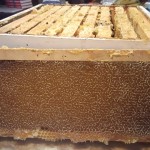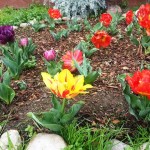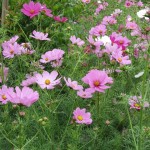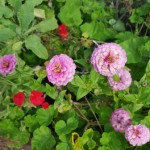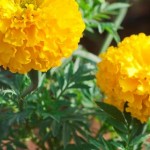Archive for November, 2017
Autumn Brings A Honey Harvest and Hive Treatment
Harvesting sweet-tasting, amber-colored honey from my hives has become an autumn ritual. This past Sunday, my beekeeper neighbor and I opened, inspected, and removed ten frames of honey from the one hive I have left.
The other hive succumbed to stress, a hive beetle infestation, and a steady march of ants. This despite me keeping my hives (and the apiary) pristine, dry, and facing the sun.
I found a beetle (no larvae) in the super we removed from the hive box when I scraped the frames clean of wax and bee glue. The tiny black insect had established itself in a crack under a plug of wax. Bees can’t sting through the beetle’s hard shell.
Without a powerful way of combating an infestation of beetles, the hive becomes stressed.Thank goodness, my neighbor had just the treatment to eliminate any other unseen beetles from my hive box.
Beetle Bee Gone sheets are an all natural and chemical-free method for treating hive beetle. Bees munch on the sheet that then becomes a fuzzy trap that ensnares the beetles. The beetles die.
In cool weather, which is what we have now, the hive beetle moves to the interior, above the brood, and/or under the hive cover. When the weather gets warmer, the pests move downward and so the placement of the sheets must be moved down.
My neighbor also inserted under the hive box lid a small plastic trough (as long as a pencil) with holes. He poured vegetable oil into the trough until it was half full. This, too, is a natural treatment against the hive beetle. The pests drown.
I’m optimistic that these treatments (along with others I’m using for mites) will keep the hive protected over winter so that in spring, I’ll get a new swarm to grow my diminished colony.
With the bees tended to, I turned my attention to the honey harvest. In all, the single super of ten frames produced roughly three gallons of honey once I’d prepped the frames and put them in the extractor. That’s more than enough honey to get my family through the winter and to present as gifts to friends along with jars of fruit jams and homemade sweets come Christmas.
_________________________________________________________________
If you enjoy reading about backyard beekeeping, caring for chickens, or growing organic vegetables, check out my Henny Penny Farmette series of books. All are available through traditional and online bookstores. To see more, click on the link.
Let’s Talk Tulips
A jolt of color can energize dreary surroundings. Imagine seeing a pot of searing-red or brilliant yellow tulips in full bloom in a window box or in your garden when little else is blooming in early spring.
Right now, many garden centers, DIY nurseries, online plant retailers, and seed catalogs feature tulips bulbs for sale. Fall is the time to plant them for spring blooms.
The standard tulip is an excellent cut flower. It offers consistent pure color in a single layer of petals. A double tulip possesses two petal layers and provide lush color grouped together with other tulips or in a cut-flower arrangement.
Kaufmanniana tulips are short in height with pointed petals. In bright sunlight the tulip bloom will open wide to lie almost flat making them the perfect bulb to grow in a rock garden.
Parrot tulips come in a variety of colors and have ruffled petals. These beauties grow fast (stalks bend a bit more than the standard tulip because of the weight of the bloom), and are multi-colored. See, http://www.hollandbulbfarms.com/items.asp?cat=Parrot-Tulips&Cc=TULIPPARROT

Inspired by parrot tulips years ago, I made this pique assiette mosaic on the step up into my garden
Fringed tulips feature a bloom edge that resembles fringe. The edges have also been described as frilly or ragged. Nevertheless, these are beautiful grouped together in an arrangement or simply enjoyed in a bed in the garden or a pot on the patio.
A bi-colored tulip surprises with a two-color bloom–perhaps an orange with a purple base. Prinses Irene is a beautiful specimen of this type of tulip.To see an image, check out https://www.whiteflowerfarm.com/211402-product.html
Rembrandt tulips are striped and tall and stand out anywhere they’re planted. Today’s version of this tulip is a non-viral variety (a virus is what originally caused the striping element of the standard tulip.
Emperor tulips feature bold color, large delicate blooms, and variable height. Although Emperor is the common name, these tulips also are known as Fosteriana tulips. They came from a wild mountainous species found in Central Asia. See, http://www.tulipworld.com/Fall-Planted-Bulbs/Tulips/Fosteriana-Tulip/Red-Emperor-Tulip.aspx
As its name implies, the Lily-flowering tulips in bloom have the appearance of lilies. The bloom looks like a star-shaped cup. Although color choices are limited, the hue is rich–for example, a fiery red with yellow-tinged edges of the Aladdin type. See, https://www.tulips.com/product/aladdin/lily-flowering-tulips
There are many more types of tulips–those I’ve mentioned are only a few. Now is the time to search your garden centers for the tulips you want blooming in your spring garden. There are many to choose from so if you don’t find what you’re looking for at your local nursery, check seed catalogs or online nurseries that can ship bulbs directly to you.
___________________________________________________________
If you enjoy reading about gardening topics, check out my Henny Penny Farmette series of cozy mysteries. Interspersed throughout the book are tips on growing plants, keeping bees and chickens, and delicious farm-to-table recipes and, of course, there’s a cozy mystery to solve.
A Beeline to Murder, The Murder of a Queen Bee, and A Hive of Homicides are all available from traditional bookstores everywhere and online. Click on the URL for more information: http://tinyurl.com/ya5vhhpm
When a couple is killed at a local winery after renewing their wedding vows, ex-cop turned farmette owner Abigail Mackenzie launches a personal investigation of her own. The victims are her good friend Paola Varela and Paola’s husband Jake Winston. Jake was a good-looking, a town flirt, and someone who’d had an affair that had ended tragically. Was he finally getting a karmic payback from an incensed husband or boyfriend? Or, was Paola the intended target?
Also see, http://tinyurl.com/yd7pz7af
Time to Harvest Seeds from Annuals
If you are like me, you hate to see anything wasted. Case in point, seeds from a summer flower garden.
Walking around my farmette this time of year, I see many seed pods on flowers that I can take off, dry, and store. Scores of my flowering plants are perennials that come back again next year, but may others are annuals, grown throughout one season.
Just because they are annuals doesn’t mean that I have to buy new seed in order to grow them next year. No. I will gather their seeds (found in flower heads or seedpods or the calyx, located at the base of the flower on the plant). I can then pull the annual and toss the plant biomass into compost pile. The seeds I’ve collected will be further dried and stored in paper envelopes labeled with the date collected and the plant’s name and color.
In the plant store you’ll find hybridized plants along with those NOT MARKED as F1 hybrids. Seeds you collect from the non-hybridized plants will come back true to their parents the next year. Non-hybrids include heirloom, open-pollinated plants that some gardeners (myself included) prefer for their gardens.
This year, I sowed zinnia seeds that I had collected two years ago. Tossing them into a bare area of the garden, I forgot about them. When they not only grew but bloomed profusely, I felt immensely pleased with myself for taking the time to collect that seed.
Zinnias are annuals. Their tiny seeds are located in the flower heads. They can be removed once the plant has finished blooming and dried.
Nasturtiums are annuals that drop their seeds (the size of a pinto bean) and will often re-seed where they’ve grown before. I like to collect these into paper envelopes and label according to color and whether they grow as a vine or bush. They actually prefer poor soil and bloom well in full sun (less so, in shade). Nasturtiums are also edible flowers–just wash, dry, and toss into a salad or use as a garnish.
Petunias are lovely annuals that carry their seed in the calyx (just under the flower). The calyx swells with seeds so you’ll want to remove the dead flowers along with the part of the stem that includes the calyx (top of stem) . Pull off the petals. When the calyx dries and splits open, you’ll see the seeds. Save these for planting.
Marigolds add splashes of bright yellow color to your garden. Remove the dead flowers and save part of the thickened stem beneath the flower head (the calyx). Split open the calyx at the top of the stem to find the long, slender seeds. Dry and save these for your next year’s flower garden.
There are lots of other annuals that you can grow in a flower garden if you take the time to harvest and dry their seeds. Consult a gardening guide or plant grower’s catalog to learn more about the annuals you might want to grow. Then give seed harvesting a try so that you’ll get all your favorite blooms in a future garden.
____________________________________________________
If you enjoy reading about gardening and other farming topics, check out my newest novel, A HIVE OF HOMICIDES. It contains not only an entertaining mystery but also tips for growing plants and trees, keeping chickens and bees, and making delicious farm-wholesome foods.
Click here to see more: http://tinyurl.com/ya5vhhpm
 Facebook
Facebook Goodreads
Goodreads LinkedIn
LinkedIn Meera Lester
Meera Lester Twitter
Twitter




